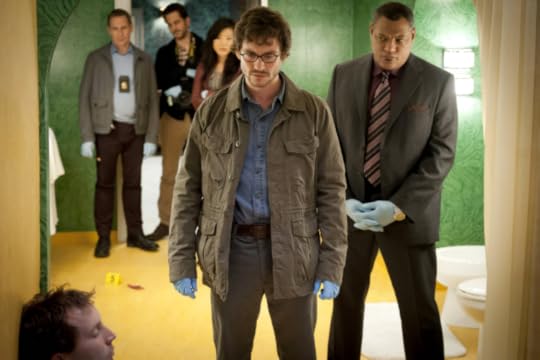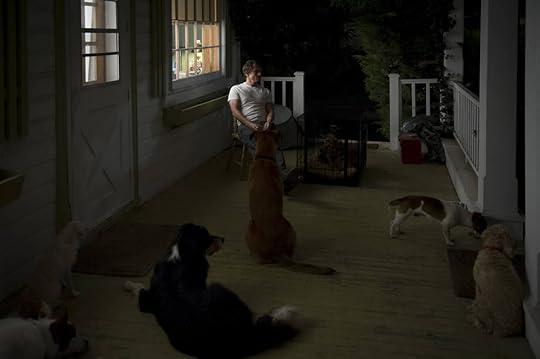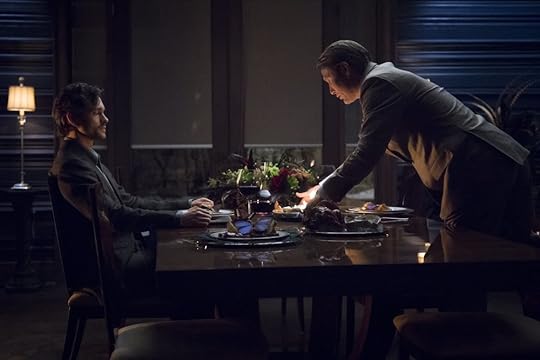This is a Story about Houses: The Relationship Between Will Graham and Edward Hopper

Will Graham, Subjectivity, and the Gaze
For me, I understood - because I’m obsessed with both of these artists - that Hannibal was going to be a juxtaposition of the artistic styles of Francis Bacon, against Edward Hopper. That really was the informing vision for the show. Will Graham is very much Edward Hopper, Hannibal Lecter is very much Francis Bacon, and what happens when those two worlds come crashing together?
— Bryan Fuller, Crave Online, November 2015
Spaces are vital things in the language of visual storytelling. Will Graham of NBC’s Hannibal is a character very much defined by his spaces. Never at home within the slick, cultured veneer of metropolitan living (the explicit domain of the show’s titular Hannibal Lecter), Will lives in a little house on a tidy parcel of land. He singularly haunts cluttered rooms, occupied by his pack of rescued dogs and strays that break the silence of an insular rural life in Wolftrap, Virginia.
The house is where Will is as safe as he can, against the horrors of his own imagination. It is his boat on a stormy sea. In this little house, Will is also most himself, shielded from the power of the gaze of others. Because in the context of Hannibal’s claustrophobic, fishbowl of a universe, Will is the consummate subject to gaze.

Be it the gaze of the audience, the scrutiny of both Jack Crawford and Alana Bloom with respect to his mental state, or the pervasive, penetrative study of Hannibal Lecter, Will Graham is always being watched. He is always influenced by and reflective of the anticipation of others. Through his empathy disorder, he assumes their perspectives, attempts to meet their expectations, and mirrors what they want him to be. The world is dangerous to Will Graham, and so are its people, their best intentions aside. They study him, they manipulate him, and they fray at the corners until he can no longer protect himself from their influence.
This is how the audience can best understand Will: as a man in an intimate relationship with his house. It harbors him, shelters him, and contains the parts of him that threaten to leech out. To better understand this, one must look to the work of Edward Hopper for context.
Edward Hoppper and The Power of Looking
There is a sort of elation about sunlight on the upper part of a house.
— Edward Hopper
Edward Hopper is one of the most immediately recognizable 20th century realists, and one of the most significant American artists in the period. Unlike some of his contemporaries, Hopper’s vision of realism focused less on photorealistic replications of human life. Instead, Hopper privileged the stillness of empty cityscapes and wide, open rural scenes. His sparsely populated canvases flatten refined, photorealistic detail into soft fields of color and relaxed, rounded shapes. Here, lonely figures negotiate the gaze of their viewer, as well as the intrusion of the modern world itself, as it penetrates the canvas itself.
[image error]
Edward Hopper, "New York Office," 1962
Hopper’s figures are often framed by windows, doorways, or other architectural design, holding the viewer at a relative distance. They are disconnected from their surroundings by doors or windows, left with their own thoughts even as they look out onto the city or fields outside. So, too, does the world stare back at them, where the boundaries of glass are made transparent to invite the gaze of the viewer upon them. To fill the vacant spaces of diners after dark, lonesome hotel rooms, or intimate moments in hallways or bedrooms.
[image error]
Edward Hopper, "High Noon," 1949
There is an inherent voyeurism imbedded within Hopper’s work and our engagement with it. It asks the viewer to confront their own need to look – their desire to look, and their privilege in doing so – by making them aware of the constructions that permit their gaze. We are looking into rooms, into moments, and into the lives of people deep in the throes of the mundane. Hopper wants us to remember that.
Houses and buildings are safe spaces in Hopper’s aesthetic schema; like boats at sea, they are adrift in a vast and alienating world. These spaces allow the shadows of common, human sadness to play against bright, warm pools of sunshine or neon light, diffused against wood paneling or bare concrete. Here Hopper’s lonely figure seek shelter from the gaze of others. Whether they are successful, the viewer is left to discern.
Houses, Containment, and the Extension of Self
Sometimes at night I would leave the lights on in my little house and walk across the flat fields. When I looked back from a distance, the house looked like a boat at sea, and all around me the vast Delta night.
— Thomas Harris, Foreword to a Fatal Interview

[image error]
Edward Hopper, "Cape Cod Morning," 1950
This is how we can understand Will Graham. In Hopper’s muted pallets of deep greens, cool blues, and all manners of dusty, earthy brown. They provide visual harmony between Will’s wardrobe and the interior of his house, drawing them together through the small details of plaid shirts and textured wallpaper. The wide porch is his island in the dark, a bright, warm place that wards off the quiet night outside. His house holds nature at bay, as the natural world looms in the peripheral, but with respect.

[image error]
Edward Hopper, "Summer Evening," 1947
The aesthetics of loneliness frame Will in windows and doorways. These guiding architectural mechanisms invite the viewer into his little house, filled with the vague artifacts of rural living. Old books and an out of tune piano; eclectic secondhand furniture and homely framed landscape artwork; fishing gear and old boat motors. Half-empty bourbon bottles and glasses in key frames compound that loneliness in shorthand. The details evoke a Hopper-like sensation of voyeurism of gazing into lived-in spaces, where the minutiae of Will’s interiority are flattened to imitate the stillness of a painting.

[image error]
Edward Hopper, "Eleven A.M.," 1926
Both in Baltimore and at Quantico, surrounded by people and more architecturally complex urban spaces, Will is still a man living in Hopper’s world. Muted, rumpled, and slightly oversized wardrobe choices often make him appear smaller and set apart from others. He is marked as plain, simple, and provincial, and constantly in negotiation with his surroundings. This carries from the sleek, metallic intimation of mid-century aesthetics at the offices and labs at Quantico, to the lavish, yawning interiors of Hannibal’s home and office spaces. Wherever he is, Will is a little disheveled, a little remote, and hiding behind the oft-crooked frames that allow him to avoid eye contact in social situations.

[image error]
Edward Hopper, "New York Movie," 1939
As the narratives progresses into the second season, Will spends more time away from his house as a common setting. From here, he is both literally and figuratively consumed by Hannibal’s visually oppressive company. Hannibal, by contrast, is entrenched in the sensibilities of the modern, affluent cosmopolitan. His domain is that of superfluity, in every conceivable sense. From music to food, interior design to costuming, every aspect of his life is designed in the service of overindulgence. Hannibal quite simply assaults the viewer under the facade of intellectual curation and good taste, and is charming enough to get away with it.
At his most simplistic, however, Hannibal is an abstract study in the theatricality of Francis Bacon. He is the intersection of the physical and the existential, where the destruction of the human body is raised to the level of art in the pursuit of pure sensorial experience. He uses the markers of class, status, and high culture to disguise his barbarism as an exercise in superiority over “pigs” and “sheep.” But for all his pretense, Hannibal is more beast than man.

[image error]
Francis Bacon, "Figure with Meat," 1954
While Will’s aesthetics privilege simplicity and stillness of being, Hannibal’s are rooted in opulence and debauchery – blood and bone – polished to a deceptive mirror-shine. Like the living embodiment of Bacon’s Painting (1946), Hannibal is both decadent and grotesque in equal, sumptuous measure. In turn, Will’s core sense of self becomes influenced by and conjoined with that of Hannibal Lecter. This is reflected in his complementary costuming and increasingly cruel outward behavior, as Will is further and further engrained in Hannibal’s world of exalted, absurd depravity.

[image error]
Francis Bacon, "Second Version of Painting (1946)," 1946
Some of this is, of course, performative. “I’m a good fisherman, Jack,” Will says as he knowingly endears himself to Hannibal in order to entrap him for Jack Crawford and the FBI. His innate propensity for violence is less focused and developed than Hannibal’s, but also less self-indulgent. Will prefers his barbarism in the name of a cause or a goal, rather than delight for its own sake. Similarly, his changes in wardrobe negotiate Hannibal’s persuasion through reserved color and material choices, adapting to urban sensibilities without lapsing into extravagance. However, this steady erosion of self coincides with his increasingly distant relationship with his house-as-shelter.
Without that shield of isolation from others, Will is subject to influence. He begins to reproduce the violent nature that Hannibal fosters within him, reflecting it as Hannibal desires of him to as a friend, acolyte, and eventual romantic partner. Which is not to say that Will does not influence Hannibal (which is another essay in and of itself), just that Will’s evolution is largely external and cosmetic. Over time, he is less defined by Hopper’s aesthetic agenda, as his interiority is less apparent in the household that once represented it.


By the third season, when Will abandons his home entirely, he is no longer the man he once was. He trades his homestead for a literal boat and takes to the sea, chasing after Hannibal Lecter in Florence. Will no longer negotiates the gaze, be it of either the audience or Hannibal himself. He no longer hides within the safety of his own four walls, hungry for the sense of wholeness in self-imposed isolation. Brick by brick, Will is becoming someone – and something – other.
Eventually, Will untangles himself from Hannibal and marries Molly Foster. He moves into her life and respective rural home, in a symbolic return to his former vision of idyllic stillness. This space, however affirmative, is filled with objects and furnishings that reflect Molly’s specific interiority, not his. In the meantime, his own interior life has disassembled and replaced by what Hannibal has left behind. Will, as the audience know him, is seeping. He is no longer contained by the Hopper-esque silence of Wolftrap. Instead, and with hardened edges, he inevitably looks forward, disregarding his own previous need for boundaries – both real and imagined – to willingly joins Hannibal in his world.
It is in this collision of aesthetics where Will Graham finally leaves Edward Hopper – and his little house – behind.



